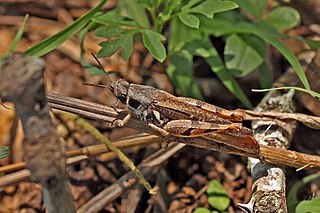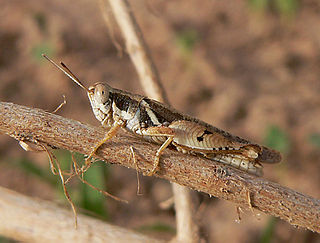
Squirrels are members of the family Sciuridae, a family that includes small or medium-sized rodents. The squirrel family includes tree squirrels, ground squirrels, and flying squirrels. Squirrels are indigenous to the Americas, Eurasia, and Africa, and were introduced by humans to Australia. The earliest known fossilized squirrels date from the Eocene epoch, and among other living rodent families, the squirrels are most closely related to the mountain beaver and to the dormice.

Genus is a taxonomic rank above species and below family as used in the biological classification of living and fossil organisms as well as viruses. In binomial nomenclature, the genus name forms the first part of the binomial species name for each species within the genus.

Rhododendron is a very large genus of about 1,024 species of woody plants in the heath family (Ericaceae). They can be either evergreen or deciduous. Most species are native to eastern Asia and the Himalayan region, but smaller numbers occur elsewhere in Asia, and in North America, Europe and Australia.

Extinction is the termination of a taxon by the death of its last member. A taxon may become functionally extinct before the death of its last member if it loses the capacity to reproduce and recover. Because a species' potential range may be very large, determining this moment is difficult, and is usually done retrospectively. This difficulty leads to phenomena such as Lazarus taxa, where a species presumed extinct abruptly "reappears" after a period of apparent absence.

The cicadas are a superfamily, the Cicadoidea, of insects in the order Hemiptera. They are in the suborder Auchenorrhyncha, along with smaller jumping bugs such as leafhoppers and froghoppers. The superfamily is divided into two families, the Tettigarctidae, with two species in Australia, and the Cicadidae, with more than 3,000 species described from around the world; many species remain undescribed. Nearly all of cicada species are annual cicadas with the exception of the few North American periodical cicada species, genus Magicicada, which in a given region emerge en masse every 13 or 17 years.

The International Union for Conservation of Nature (IUCN) Red List of Threatened Species, also known as the IUCN Red List or Red Data Book, founded in 1964, is an inventory of the global conservation status and extinction risk of biological species. A series of Regional Red Lists, which assess the risk of extinction to species within a political management unit, are also produced by countries and organizations.

Endemism is the state of a species only being found in a single defined geographic location, such as an island, state, nation, country or other defined zone; organisms that are indigenous to a place are not endemic to it if they are also found elsewhere. For example, the Cape sugarbird is found exclusively in southwestern South Africa and is therefore said to be endemic to that particular part of the world. An endemic species can also be referred to as an endemism or, in scientific literature, as an endemite.

The conservation status of a group of organisms indicates whether the group still exists and how likely the group is to become extinct in the near future. Many factors are taken into account when assessing conservation status: not simply the number of individuals remaining, but the overall increase or decrease in the population over time, breeding success rates, and known threats. Various systems of conservation status are in use at international, multi-country, national and local levels, as well as for consumer use such as sustainable seafood advisory lists and certification. The two international systems are by the International Union for Conservation of Nature (IUCN) and The Convention on International Trade in Endangered Species of Wild Fauna and Flora (CITES).

A species is often defined as the largest group of organisms in which any two individuals of the appropriate sexes or mating types can produce fertile offspring, typically by sexual reproduction. It is the basic unit of classification and a taxonomic rank of an organism, as well as a unit of biodiversity. Other ways of defining species include their karyotype, DNA sequence, morphology, behaviour, or ecological niche. In addition, paleontologists use the concept of the chronospecies since fossil reproduction cannot be examined. The most recent rigorous estimate for the total number of species of eukaryotes is between 8 and 8.7 million. About 14% of these had been described by 2011. All species are given a two-part name, a "binomial". The first part of a binomial is the genus to which the species belongs. The second part is called the specific name or the specific epithet. For example, Boa constrictor is one of the species of the genus Boa, with constrictor being the species' epithet.

Dogon country is a region of eastern Mali and northwestern Burkina Faso populated mainly by the Dogon people, a diverse ethnic group in West Africa with diverse languages. Like the term Serer country occupied by the Serer ethnic group, Dogon country is vast, and lies southwest of the Niger River belt. The region is composed of three zones: the plateau, the escarpment and the Seno-Gondo plain.
Cimmeritodes is a genus in the beetle family Carabidae. There are about six described species in Cimmeritodes, found in China.

Catantops is a genus of grasshoppers in the tribe Catantopini and is typical of the subfamily Catantopinae. Species can be found in Africa, including Madagascar and subcontinental India.

Cryptocatantops is a genus of grasshoppers in the subfamily Catantopinae, a group of insects primarily found in Africa. As numerous other genera, it is not yet assigned to a particular tribe.
Cryptocatantops debilis is a species of grasshoppers in the subfamily Catantopinae, a group of insects commonly called spur-throated grasshoppers. The type specimen was a female found in Omaruru, Namibia.
Maxanapis is a genus of Australian araneomorph spiders in the family Anapidae, first described by Norman I. Platnick & Raymond Robert Forster in 1989.

Cryptocatantops haemorrhoidalis is a species of grasshopper in the Cryptocatantops genus.
Cryptocatantops allessandricus is a species of grasshopper in the Cryptocatantops genus.
Cryptocatantops simlae is a species of grasshopper in the Cryptocatantops genus.
Cryptocatantops uvarovi is a species of grasshopper in the Cryptocatantops genus found in Somalia.











